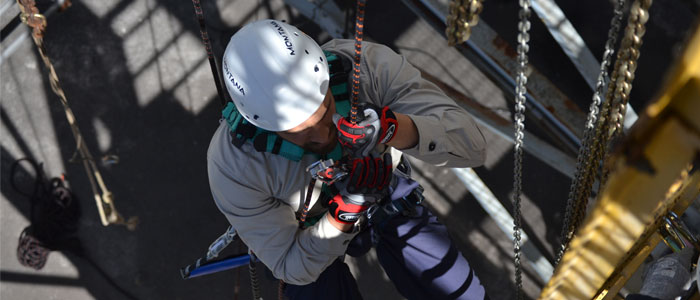Working at height demands special attention to the PPEs to be used. According to NR 6, it is the company’s duty to provide the appropriate material for the professionals to perform their activities. And it is the employee’s obligation to correctly use and maintain the PPE for Work at Height. An important and very necessary item is the Fall Arrest Device.
The Fall Arrest Device is a mechanical locking device that should make the connection between the safety belt and the anchorage point that will prevent the worker from falling while working.
This Work at Height equipment, when supplied, is mandatory for activities in which the worker will be at least two meters above the ground, running the risk of falling. Activities that need the use of scaffolding and ladders, cleaning and painting outside buildings, maintenance of signal towers and roofs, and general tasks that require the suspension of the worker.
Difference between a Fall Arrest Device and a Safety Lanyard
Although it seems that both PPE for Work at Height are responsible for the same function, they must be used separately, because they play different roles in protecting the worker. In this post we will explain the difference between the two pieces of equipment.
Fall Arrest Devices: their function is to prevent the worker from falling, by locking the safety harness and the professional so that they do not collide with the ground. It can be composed of synthetic straps, ropes or cables, equipped with a braking system, springs and items that work without the worker’s interference. In addition, the Fall Arrest is also used with the lifeline.
Safety Lanyard: Its function is to allow the worker to move safely from one side to the other while performing his tasks. It is composed of synthetic fibers, straps or ropes, and steel hooks. Its operation depends on the worker’s action. The safety lanyard is not used with the lifeline.
Types of Fall Arrest Devices
The Fall Arrest Device can be sliding, being attached to a lifeline placed in a vertical position and making the displacement movements on an anchoring line that can be rigid or flexible. The rigid anchoring line is composed of a rail or steel cable. The flexible anchoring line can be made of synthetic rope or a steel cable.
When to use the Sliding Fall Arrest Device:
Building façade work.
Suspended scaffolding.
Suspended chairs.
Ladders.
Any access that uses ladders and exceeds the maximum height allowed without fall protection PPE (2m)
The Fall Arrest Device can also be portable retractable. In this case, it can be composed of a steel cable or rolled-up tape, which retracts or extends by means of a spring, depending on the vertical locomotion of the worker. When an impact occurs, the system locks automatically and prevents movement.
When to use the Retractable Fall Arrest Device
Work with vertical or horizontal movement.
Activity with the help of trolleys.
Loading and unloading trucks.
Safety at heights
The Fall Arrest Device is an essential EPI for Work at Heights and must be used whenever necessary. It is important to know the differences between the sliding and retractable to understand when each one should be used. In addition, one should seek Protective Equipment that has a valid CA to ensure the acquisition of quality material, and perform periodic maintenance of the Fall Arrest Device.
We hope this content is useful and that it can help you when deciding on any issue regarding Fall Arrest Devices or Working at Height.
Now we want to know, do you have any more questions about it? Did you like the information? Leave your comment below and let’s continue this conversation.
Whenever you need valuable information about Fall Protection, come visit us, because this is the Work at Height Experts Blog.
